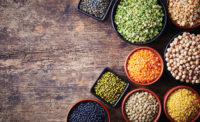
DF: Debra, please explain to Dairy Foods' readers how cows milk products are the perfect carrier for soy protein.
DM: The Solae Company believes that dairy and soy are a great match! By combining them, you can develop products that deliver the advantages of both dairy and soy: High-quality protein and different nutrition benefits unique to soy and dairy. In fact, dairy and soy protein are complementary from a product development standpoint. In sensory profiling that we have done at Solae, combination dairy/soy products receive very favorable hedonic ratings. We believe there is significant market opportunity for combination products, building on the great tradition and consumer acceptance of milk, enhanced with the healthful benefits of soy protein.
DF: Recently soy has been making headlines with new research findings. Please share some of the latest.
DM: Yes, media coverage has focused on soy protein as part of lower-carbohydrate diets, as powerhouse antioxidant foods, top-10 lists of healthy foods and coverage of new soy nutrition research. This includes an emphasis on cardiovascular health. In 1999, the evidence was so compelling that FDA approved a health claim stating that the consumption of soy protein, as part of a healthful diet, can help reduce the risk of coronary heart disease. New research continues to focus on heart health.
Studies have also found that soy protein can aid in the development of insulin resistance and help moderate blood glucose. Additionally, foods that include soy protein can be helpful for people with diabetes who are at risk of kidney failure, because soy protein has been shown to be well tolerated by people who are undergoing hemodialysis.
In the area of cognitive function, a study on college-aged people found that consuming soy protein for 10 weeks (delivering about 100mg of the bioactive isoflavones) resulted in significantly better memory function in both men and women.
Soy isoflavones are sometimes called phytoestrogens because they have a similar molecular shape as estrogens produced by the body. However, these plant estrogens are much weaker than the body's own estrogen-estimates are 10,000 to 400,000 times weaker. Isoflavones can have mild estrogen effects and anti-estrogen effects by blocking the more powerful estrogens produced by the body from their actions in the cell. These actions are beneficial in relieving hot flashes and night sweats associated with menopause in women and may reduce the risk of prostate cancer in men.
Furthermore, large population studies have shown that those who consume the most soy-containing foods have the lowest risk of prostate, gastrointestinal tract and breast cancers. Solae recently submitted a petition to FDA to allow a health claim for soy protein and reduced risk of these cancers. The health claim petition currently is being reviewed by FDA.
DF: How does a dairy processor work with soy as an ingredient?
DM: How soy protein is used in an application is dependent on the particular application. In a typical dairy operation, a processor will have the equipment and process technology required to effectively manufacture products incorporating soy proteins. Most soy proteins that are appropriate for dairy-type applications, such as beverages, cultured products or frozen desserts, come in powdered form. Therefore, the ability to hydrate the protein prior to incorporation into an application is typically required.
In regard to usage levels, it depends on the product, its positioning and target consumer. To make the soy protein and heart health claim, 6.25g of soy protein are required per serving. So, many manufacturers have this level as a goal. However, you can formulate great-tasting products that include Solae soy protein at a wide variety of usage levels. For example, Solae has formulated beverages for customers that deliver anywhere from 3g to 20g of Solae soy proteins per serving.

DM: As I mentioned before, any food or beverage, including fluid cows milk, must contain 6.25g of soy protein per serving to make the heart health claim. This amount is one-fourth of the 25g suggested per day and is based on four eating occasions. To qualify for the claim, a food must also be low in fat, saturated fat and cholesterol and also relatively low in sodium.
DF: What are the best dairy applications for soy?
DM: Solae believes the most immediate opportunities are in beverages, spoonable and drinkable cultured products and frozen desserts. Soy protein is very compatible in these systems, and consumers say they would like to find soy protein's healthful benefits in these applications. In beverages, Solae offers technologies that function in both acidic (more juice-like) beverages and in neutral (more milk-like) beverages. Flavored neutral beverages, targeting kids or adults, are a great fit. And cultured, probiotic beverages and spoonable desserts are emerging as a great opportunity. With soy and dairy combined, there are many different healthful product positionings available to explore.
DF: In your opinion, will dairy and soy ever be friends and made available to U.S. consumers in one dairy product?
DM: With Solae's technology, applications capabilities and consumer insights, we are in a unique position to help dairy processors realize the market opportunities for such products. We view combination dairy/soy products as a significant market opportunity, and we have been actively developing technology specific to this area. Right now, in certain segments of the food industry, such as nutritional beverages and nutritional bars, there are many successful commercial examples of products based on a combination of dairy and soy proteins. It's only a matter of time before similar opportunities begin to emerge in the dairy foods segment.
For more information on Solae soy proteins, including use in dairy food and beverage applications, call 800/325-7108, or visit www.solae.com.
